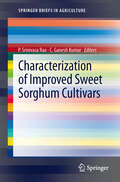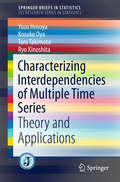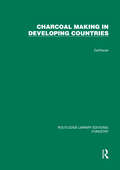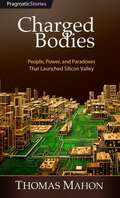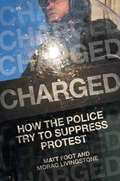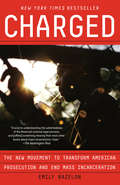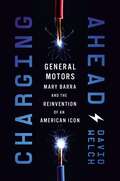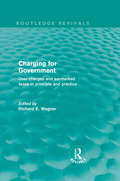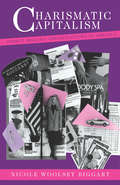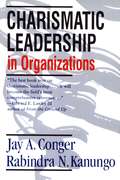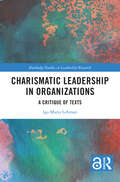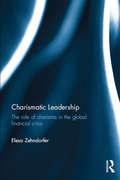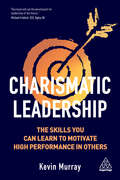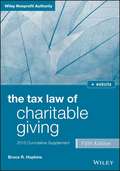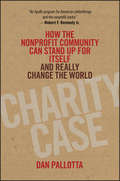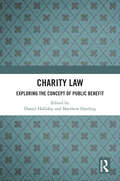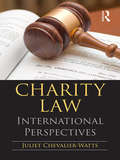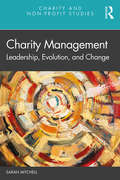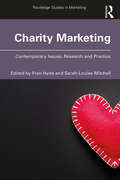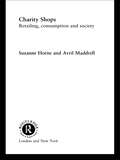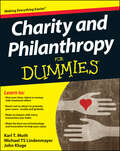- Table View
- List View
Characterization of Improved Sweet Sorghum Cultivars (SpringerBriefs in Agriculture)
by C. Ganesh Kumar P. Srinivasa RaoA number of driving forces, including the soaring global crude oil prices and environmental concerns in both developed and developing nations has triggered a renewed interest in the recent years on the R&D of biofuel crops. In this regard, many countries across the globe are investing heavily in the bioenergy sector for R&D to increase their energy security and reduce their dependence on imported fossil fuels. Currently, most of the biofuel requirement is met by sugarcane in Brazil and corn in the United States, while biodiesel from rapeseed oil in Europe. Sweet sorghum has been identified as a unique biofuel feedstock in India since it is well adapted to Indian agro-climatic conditions and more importantly it does not jeopardize food security at the cost of fuel. Sweet sorghum [Sorghum bicolor (L.) Moench] is considered as a SMART new generation energy crop as it can accumulate sugars in its stalks similar to sugarcane, but without food¬¬-fuel trade-offs and can be cultivated in almost all temperate and tropical climatic conditions and has many other advantages. The grain can be harvested from the panicles at maturity. There is no single publication detailing the agronomic and biochemical traits of tropical sweet sorghum cultivars and hybrid parents. Hence, an attempt is made in this publication- "Characterization of improved sweet sorghum cultivars" to detail the complete description of cultivars. This book serves as a ready reference on the detailed characterization of different improved sweet sorghum genotypes following the PPVFRA guidelines for the researchers, entrepreneurs, farmers and other stakeholders to identify the available sweet sorghum cultivars and understand their yield potential in tropics.
Characterizing Interdependencies of Multiple Time Series: Theory and Applications (SpringerBriefs in Statistics)
by Yuzo Hosoya Kosuke Oya Taro Takimoto Ryo KinoshitaThis book introduces academic researchers and professionals to the basic concepts and methods for characterizing interdependencies of multiple time series in the frequency domain. Detecting causal directions between a pair of time series and the extent of their effects, as well as testing the non existence of a feedback relation between them, have constituted major focal points in multiple time series analysis since Granger introduced the celebrated definition of causality in view of prediction improvement. Causality analysis has since been widely applied in many disciplines. Although most analyses are conducted from the perspective of the time domain, a frequency domain method introduced in this book sheds new light on another aspect that disentangles the interdependencies between multiple time series in terms of long-term or short-term effects, quantitatively characterizing them. The frequency domain method includes the Granger noncausality test as a special case. Chapters 2 and 3 of the book introduce an improved version of the basic concepts for measuring the one-way effect, reciprocity, and association of multiple time series, which were originally proposed by Hosoya. Then the statistical inferences of these measures are presented, with a focus on the stationary multivariate autoregressive moving-average processes, which include the estimation and test of causality change. Empirical analyses are provided to illustrate what alternative aspects are detected and how the methods introduced here can be conveniently applied. Most of the materials in Chapters 4 and 5 are based on the authors' latest research work. Subsidiary items are collected in the Appendix.
Characterizing the U.S. Industrial Base for Coal-Powered Electricity
by Henry H. Willis Constantine Samaras Jeffrey A. Drezner Evan BloomTo determine whether the industrial base for the U. S. domestic coal-based electricity generation industry can maintain the capability to design, construct, operate, and maintain coal-fired electricity generating units within reasonable cost, schedule, performance, environmental, and quality expectations, this book reviewsinterviews with stakeholders and data describing key elements of industry capability and validation or verification of concerns.
Charakteristika von Aufgaben in der Domäne Rechnungswesen: Eine fachdidaktische Analyse
by Simone StützDas vorliegende Buch beschäftigt sich mit den Charakteristika von Aufgaben in der Domäne Rechnungswesen aus einer fachdidaktischen Perspektive. Dazu wurde der aktuelle fachdidaktische Diskussionsstand aus der Fachdidaktik Rechnungswesen aufgearbeitet und auf Basis dessen ein umfassendes Kategoriensystem zur Analyse und Bewertung von Aufgaben aus dem Rechnungswesen entwickelt. Das Kategoriensystem kann des Weiteren genutzt werden, um neue Aufgaben für das Rechnungswesen zu entwickeln und bestehende Aufgaben zu optimieren. Darüber hinaus wurden 2.000 Rechnungswesenaufgaben aus 15 verschiedenen Schulbüchern von drei österreichischen Verlagen mithilfe des Kategoriensystems analysiert und bewertet. Damit kann der Wissensstand zu den Charakteristika von Aufgaben in der Domäne Rechnungswesen erheblich erweitert werden. Die Ergebnisse der umfassenden Auswertungen zeigen, dass bei den Aufgaben Verbesserungspotenzial besteht und die im Rahmen des Kategoriensystems formulierten Ansprüche an Aufgaben im Rechnungswesen derzeit nicht umfassend erfüllt werden. Darüber hinaus wird festgestellt, dass im derzeitigen Rechnungswesenunterricht sowohl eine Änderung der Aufgabenkultur als auch curriculare Änderungen und Weiterentwicklungen notwendig sind.
Charcoal Making in Developing Countries (Routledge Library Editions: Forestry)
by Gerald FoleyOriginally published in 1986, this book provides a detailed examination of programmes to introduce improved charcoal making techniques throughout the developing world. Charcoal making is widely regarded as an extremely wasteful use of scarce wood resources. The book includes a section on the physics and chemistry of charcoal and descriptions of the various traditional methods of charcoal making. Patterns of charcoal supply and distribution are analysed and efforts to introduce improved charcoal making techniques are described and evaluated.
Charged Bodies: People, Power, And Paradox In Silicon Valley
by Thomas MahonAt the heart of Silicon Valley's meteoric rise is a story etched in the lives of those who shaped it and those who were forever transformed by it. Author Tom Mahon provides an insider's perspective on the birth of the semiconductor industry, which sparked the region's transformation from sleepy farmland to the heart and soul of the high-tech revolution. Through twenty-five extended, in-person interviews you'll meet a diverse cast of characters whose goal was to create technology and tools in service to humanity. In the Afterword to this edition, the author questions whether they accomplished their objectives and urges readers to rise up and rethink technology. What did it take to create the atmosphere that transformed rich farmland into the wealthy center of high-tech? Five climates lined up in just the right way. Educational institutions (Stanford and Berkeley); an attractive location with balmy, Mediterranean-like weather; a history of technology development (Federal Telegraph in the early twentieth century); financial risk taking (the gold rush); and a cultural climate near the center of an ideological revolution (the hippie movement). The Santa Clara Valley had them all. In spades. Before personal computers, or the Internet, or social media came *chips*. Inventive minds took advantage of the quad-electron structure and unique properties - insulative and conductive - of silicon to create semiconductors. But Charged Bodies is more than just the story of new technologies emerging from "The Valley of the Heart's Delight." Using an approach like The Canterbury Tales, Tom Mahon captures the spirit of Silicon Valley in the 80s through the stories of the people all around him. The inventors and bankers have their say. But so do a range of other people who lived through that transition. Listen as artists and hackers, detectives and journalists, lawyers and scientists, flappers and philosophers tell the story of Silicon Valley in their own words.
Charged: How the Police Try to Suppress Protest
by Morag Livingstone Matt FootWho do the police protect? An investigation into 40 years of battling protest that reveals a hidden police agenda against dissent. Charged is an essential investigation into the role of policing protest in Britain today. As the UK government tries to suppress all forms of dissent, in their pursuit of more control, how do the police manage crowds, provoke violence and even break the law?Since the 1980s under successive governments the police have been allowed to suppress protests, using aggressive tactics—from batons to horse charges to kettling. The landscape of how police deal with protest changed following criticism of the police during the 1981 Brixton riots. New military-style tactics were sanctioned by the Thatcher government, in secret. Over the next forty years those protesting against racism, unfair job losses, draconian laws, or for environmental protection were subject to brutal tactics. In the aftermath, media attention denigrates protesters while the police are praised and continue to act with impunity.Looking through these moments of conflict widens our understanding of policing public order to reveal the true character of the state. Since the 1980s successive governments, from Thatcher to Johnson, covertly plot to suppress protests, using standardised aggressive tactics, from batons to horse charges to kettling. Through undisclosed documents and eyewitness accounts the authors reveal organised police violence against miners at Orgreave, print workers at Warrington, anti poll tax campaigners, student protestors and Black Lives Matter. The voices of protesters have been undeterred.
Charged: The New Movement To Transform American Prosecution And End Mass Incarceration
by Emily BazelonA renowned journalist and legal commentator exposes the unchecked power of the prosecutor as a driving force in America’s mass incarceration crisis—and charts a way out.<P><P>The American criminal justice system is supposed to be a contest between two equal adversaries, the prosecution and the defense, with judges ensuring a fair fight. <P><P>That image of the law does not match the reality in the courtroom, however. Much of the time, it is prosecutors more than judges who control the outcome of a case, from choosing the charge to setting bail to determining the plea bargain. They often decide who goes free and who goes to prison, even who lives and who dies. <P><P>In Charged, Emily Bazelon reveals how this kind of unchecked power is the underreported cause of enormous injustice—and the missing piece in the mass incarceration puzzle. <P><P>Charged follows the story of two young people caught up in the criminal justice system: Kevin, a twenty-year-old in Brooklyn who picked up his friend’s gun as the cops burst in and was charged with a serious violent felony, and Noura, a teenage girl in Memphis indicted for the murder of her mother. <P><P>Bazelon tracks both cases—from arrest and charging to trial and sentencing—and, with her trademark blend of deeply reported narrative, legal analysis, and investigative journalism, illustrates just how criminal prosecutions can go wrong and, more important, why they don’t have to. <P><P>Bazelon also details the second chances they prosecutors can extend, if they choose, to Kevin and Noura and so many others. <P><P>She follows a wave of reform-minded D.A.s who have been elected in some of our biggest cities, as well as in rural areas in every region of the country, put in office to do nothing less than reinvent how their job is done. If they succeed, they can point the country toward a different and profoundly better future. <P><b>A New York Times Bestseller</b>
Charging Ahead: GM, Mary Barra, and the Reinvention of an American Icon
by David WelchMary Barra&’s quest to move GM to a manufacturer of electric cars has captured the attention of automobile aficionados, green-business advocates, and leaders of all types who have to admire Mary&’s toughness in moving forward despite the overwhelming obstacles in her path.A decade ago, no one would have guessed that GM would be the company poised to lead America into the future. At a time when business book readers seem endlessly fascinated by soaring tech giants like Amazon and Netflix, and ill-fated startups like WeWork and Theranos, why is it important to put the spotlight back on 112-year-old GM? Because Charlie Wilson&’s quip from 1952 is still true: What&’s good for GM is still good for America, and vice versa. America needs to transition to a new era of clean energy and environmentally sustainable transportation. We also need to adapt to a world with far fewer assembly-line jobs, but far more skilled jobs for people who can design, build, and operate robots and other high-tech machines. GM&’s attempt to lead those transitions is as important as it is dramatic.Equally compelling is the story of GM&’s CEO, Mary Barra, who against all odds took the reins at GM in 2014. Since that time, she has attempted to reinvent a century-old company and equip it for the biggest change in transportation since the internal combustion engine replaced the horse. In the process, she has been ripping out GM traditions by the roots—and taking flak from all sides. Her plan is to make GM—the company famed for the gas-burning Corvette, hulking Cadillac Escalade, and carbon-spewing Silverado pickup—purely electric and clean by 2035. She may not be as wealthy as Jeff Bezos, as brash as Elon Musk, or as powerful as Mark Zuckerberg, but Mary Barra is just as important as any of them. And as one of the most powerful female executives in the world, she is overdue for an in-depth look at her forward-thinking vision, her approach to leadership, and her accomplishments against the odds.
Charging for Government: User charges and earmarked taxes in principle and practice (Routledge Revivals)
by Richard E. WagnerOriginally published in 1991, user charges and earmarked taxes are methods by which people pay directly for the services they recieve from government. As such they are frequently supported by those who oppose increased taxation, who argue that they are more like market transactions than traditional forms of taxation. This book explores the cogency of these arguments in the light of public choice analyses of political processes.
Charismatic Capitalism: Direct Selling Organizations in America
by Nicole Woolsey BiggartTupperware Home Parties, Shaklee Corporation, Amway, Mary Kay Cosmetics—theirs is an approach to business that violates many of the basic tenets of modern American commerce. Yet these direct selling organizations, fashioned by charismatic leaders and built upon devoted armies of door-to-door representatives, have grown to constitute an $8. 5 billion a year industry and provide a livelihood for more than 5 million workers, the vast majority of them women. The first full-scale study of this industry, Charismatic Capitalism, revises the standard contention that the rationalization of social institutions is an inevitable consequence of advanced capitalism. Nicole Woolsey Biggart argues instead that less rational organizations built on social networks may actually be more economically viable.
Charismatic Leadership in Organizations
by Jay A. Conger Rabindra N. KanungoThis book not only integrates the growing body of research and theory on charismatic leadership, but also pushes back the frontiers of our knowledge by introducing new theories and insights. The authors present a comprehensive model of the charismatic leadership process. The model is documented by extensive empirical research and richly illustrated with case examples of corporate leaders.
Charismatic Leadership in Organizations: A Critique of Texts (Routledge Studies in Leadership Research)
by Iga Maria LehmanHistory is full of examples of how the skilful use of language is a fundamental aspect of charismatic leadership. Traditionally, this phenomenon has been studied focusing on oratory skills. The book argues that the relationship between a leader and a follower has points of similarity to that which exists between a writer and a reader, and that in each case, former party is the agenda setter, but satisfactory outcomes require a mutual endeavor. Given that scholarly writing about management and organizations is inevitably a mix of the presentation of empirical truths and value judgements, the ability to engage the reader intellectually and emotionally is critical in the successful dissemination of disciplinary knowledge and belief claims. The book proposes a multi-faceted construct of textual charisma which is created through the use of metaphors, stories and personal accounts as well as the ancient construct of pistis and the contemporary notion of metadiscourse. The proposed framework provides guidance for management and organization studies’ authors seeking to present themselves as convincing and engaging writers.
Charismatic Leadership: The role of charisma in the global financial crisis
by Elesa ZehndorferWhy is charisma so crucially important to today’s corporations? And how might its misuse have been responsible for bringing the world’s financial system crashing to its knees? Charismatic Leadership: The role of charisma in the global financial crisis provides a theory-driven and intuitively appealing analysis of the role that charisma played in the global financial crisis of 2008. It looks at how charismatic leadership can contribute to organizational effectiveness, but also considers the destructive potential of its darker side. It examines the role of charisma in fuelling investor irrationality, and the endogenous instability and boom-and-bust cycles that characterize the markets. This book unites both academic and practitioner-led approaches to produce a text that is at once stimulating and informative. Expert insights written by financial sector leaders in the ‘View from the Markets’ sections, alongside mini case studies and end-of-chapter questions, enable the reader to consolidate key theoretical points covered in each chapter. It will be of interest to advanced students and scholars in the fields of leadership and organizational studies, as well as professionals with a keen interest in this area.
Charismatic Leadership: The skills you can learn to motivate high performance in others
by Kevin MurrayWe say that someone has charisma when they can attract, inspire and influence people through their personal qualities. We think that this is a special power some fortunate individuals have that makes them able to affect and influence others at a deep emotional level, to communicate effectively with them and make interpersonal connections. But very few of us understand what charisma really is. It is not widely-applauded magnetism or shallow charm. Rather, it's the deep-rooted powerful charisma that helps people deliver incredible results. This charisma is a learnable skill. It's the result of developing specific behaviours, which are proven to improve not only how people feel about you, but which will help others change their own behaviours and achieve success. Charismatic Leadership will show you how to be a powerful influencer with your peers, your colleagues and your customers. You'll learn why charisma is a vital asset in any organization, understand its essential components, find out how to grow your charismatic presence and discover why you need the companion skills of coaching, problem-solving and empathy. Using charisma effectively helps everyone perform at a high level. This book will show you how.
Charitable Giving 2015 Supplement
by Bruce R. HopkinsThe definitive, accessible reference on charitable giving tax law Charitable Giving 5th Edition is the leading guide to the law, rules, and regulations governing charitable giving, completely revised, revamped, and updated to align with the latest developments in the industry. Written by Bruce R. Hopkins, the most respected name in the field, this book provides plain-English explanations and in-depth coverage, complete with detailed documentation, citations, and references. This updated edition contains new information on many aspects of giving law, including the extensive litigation concerning gifts of conservation easements and updates on the several special rules for unique types of giving, as well as updates on federal estate tax law, and case law on substantiation and appraisal requirements. Reader will find a summary of recent developments concerning recordkeeping, donor-advised funds, and much more. The companion website provides tables, appendices, IRS guidelines, and other related documents to help readers get organized and remain compliant amidst the rapid changes. Charitable giving law is constantly evolving, and remaining compliant can feel like trying to hit a moving target. This book is designed to keep lawyers, managers, and development directors in tax-exempt organizations up to date on the relevant regulations, with a deep understanding of how the regulations are actually applied. Understand the federal tax laws surrounding charitable giving Learn how recent legislation impacts specific taxes and documentation Examine the new regulations proposed by the Department of Treasury Gain access to tools that help ensure compliance More than a simple codification reference, this book provides explanation and interpretation from one of the foremost minds in the field. For those needing a charitable giving guide, Charitable Giving 5th Edition is a comprehensive, authoritative examination, and widely recognized as a classic reference.
Charity Case
by Dan PallottaA blueprint for a national leadership movement to transform the way the public thinks about giving Virtually everything our society has been taught about charity is backwards. We deny the social sector the ability to grow because of our short-sighted demand that it send every short-term dollar into direct services. Yet if the sector cannot grow, it can never match the scale of our great social problems. In the face of this dilemma, the sector has remained silent, defenseless, and disorganized. In Charity Case, Pallotta proposes a visionary solution: a Charity Defense Council to re-educate the public and give charities the freedom they need to solve our most pressing social issues. Proposes concrete steps for how a national Charity Defense Council will transform the public understanding of the humanitarian sector, including: building an anti-defamation league and legal defense for the sector, creating a massive national ongoing ad campaign to upgrade public literacy about giving, and ultimately enacting a National Civil Rights Act for Charity and Social Enterprise From Dan Pallotta, renowned builder of social movements and inventor of the multi-day charity event industry (including the AIDS Rides and Breast Cancer 3-Days) that has cumulatively raised over $1. 1 billion for critical social causes The hotly-anticipated follow-up to Pallotta's groundbreaking book Uncharitable Grounded in Pallotta's clear vision and deep social sector experience, Charity Case is a fascinating wake-up call for fixing the culture that thwarts our charities' ability to change the world.
Charity Law: Exploring the Concept of Public Benefit
by Daniel Halliday and Matthew HardingThis book investigates and critically evaluates the concept of public benefit within charity law in the common law world. In the course of the study the book: provides a rich account of how the concept of public benefit has developed over time in charity law jurisprudence; deepens understanding of the aspects of public benefit that remain poorly understood even today; and suggests ways in which public benefit jurisprudence might develop in an orderly and principled way so as to better address some of the core concerns of charity law and the public policy objectives that lie behind it. The book includes contributions from world leading charity law experts and jurists. Each chapter reflects on a key aspect of public benefit jurisprudence in charity law. The topics have been chosen carefully to ensure coverage of most if not all of the large unresolved questions relating to public benefit in the common law world. Each chapter is accompanied by a comment, written by an academic expert or leading practitioner. The comments complement the chapters by critically engaging with those chapters and by offering different and thought-provoking perspectives on the subject matter of the chapters. The book will be of interest to academics working in law, philosophy, economics, sociology and political science. It will also provide a valuable resource for legal practitioners and judges, government officials, especially charity regulators, and in the not-for-profit sector itself.
Charity Law: International Perspectives
by Juliet Chevalier-WattsThis work provides an analytical and comparative analysis of the development of charity law, as well as providing a critical commentary on a number of contemporary changes within the charity law field across a range of common law jurisdictions. The book follows earlier studies which cover a similar, and traditional, jurisdictional spread, but which are now dated. It further considers in detail charity law issues within Hong Kong and Singapore, about which there has been historically more limited charity law discussion. The area is growing in terms of practical legal and academic interest.
Charity Management: Leadership, Evolution, and Change (Charity and Non-Profit Studies)
by Sarah MitchellBritain faces challenges that weren’t imaginable thirty years ago, challenges which charities, rooted as they are in community action and the public good, should be ideally suited to tackle. But the charity sector seems paralysed. Even after a decade of cuts and immense social and environmental disruption charities are still fighting hard to maintain business as usual. To develop new responses to our changing world the charity sector desperately needs to reinvent itself, radically re-engaging with communities and developing powerful and scalable responses to the challenges facing the UK in the coming decades. What are the ties that bind charities, rendering them unable to re-invent themselves and to re-imagine their services, even when they face existential crises? This book explores how charities in the UK really operate, as seen through the eyes of people who work in and with charities, and investigates what holds charities back from change. It demonstrates what we can learn from entrepreneurship and market disruption in the private sector, and points to ways in which the sector can re-imagine what it does and how it does this. It presents a new ambition for charities to break free of their history and imagine a new role for themselves in shaping the future for our society. Presenting a new ambition for charities to imagine a new role for themselves in shaping the future for our society, this volume is especially valuable for academics and professionals in the fields of charity and non-profit management, organisational change, and strategic management.
Charity Marketing: Contemporary Issues, Research and Practice (Routledge Studies in Marketing)
by Fran HydeCharities operate within an increasingly challenging environment, with competition for public engagement, funding and volunteers intensifying. High-profile scandals have knocked public trust and the recent Covid-19 pandemic has illustrated how important it is for charities to provide support in times of need and fill the gap left by inadequate public sector provision. Across 12 chapters a diverse group of academics and deep-thinking practitioners present contrasting perspectives and the latest thinking on the challenges within the charity sector. The approach of the book contributes to the growing phenomenon of Theory + Practice in Marketing (TPM) presenting different perspectives and theoretical lenses to stimulate debate and future research. Charity Marketing provides a bridge between the practice of contemporary nonprofit organisations, charity marketing and recent academic insight into the charity sector. Using exemplar case studies of nonprofit and charity brands, this edited volume will be of direct interest to students, academics, marketing practitioners and researchers studying and working in charities, public and nonprofit management, and marketing.
Charity Shops: Retailing, Consumption and Society (Routledge Studies in the Management of Voluntary and Non-Profit Organizations #Vol. 5)
by Avril Maddrell Suzanne HorneIn the late 1990s, there was a distinct rise in interest in the non-profit sector, and in retailing and consumption. Drawing together these two concerns this book provides a comprehensive and international account of the retail charity sector. Charity shops are now significant occupiers of the UK high street, and are becoming familiar sites of consumption in the USA, Australia, Canada and Ireland. This volume provides the first overview of the history and development of the charity shop, incorporating material from a variety of disciplines, including marketing, retailing, cultural studies and social geography. Presenting recent research from the UK, Europe, Australia and North America, this book fills gap in the literature of the field, and will be of great interest to all practitioners, researchers and students wishing to study the charity shop phenomenon.
Charity and Philanthropy For Dummies
by Karl T. Muth John Kluge Michael T. LindenmayerThe easy way to make a difference Despite tough economic times, rates of donations are on therise. If you want to make a difference but don't know where tostart, you need Charity & Philanthropy For Dummies.This is your one-stop, no-nonsense guide to charitableactivities. Inside you'll find lots of strategies for philanthropicwork such as volunteering your time, raising funds, donating yourown cash or expertise, impact investing, and socialentrepreneurship. You'll also find lots of case studies fromcharities big and small to show you what works and whatdoesn't.Help with selecting where to donate or investIdeas for how you can make a difference without having pots ofmoneyAdvice on socially responsible and impact investingTechniques for reaching out to others to help your cause - froma local to a global levelYou don't need deep pockets to make a difference--you needCharity & Philanthropy For Dummies.
Charity or Bribery
by Eugene Soltes Brian TilleyFilip Kowalski, a senior manager at the pharmaceutical company Healthgen, leads sales for the firm’s Polish division. While pitching Healthgen’s products, he develops a relationship with a director of a regional health fund who also runs a private foundation. After a natural disaster, Healthgen—at the request of the director—donated products to help during the crises. After Healthgen wins an important contract, the media alleges that the donation was made to secure support of the regional health director. Were the efforts to boost company sales and support public health a donation or a bribe?
Charlene Barshefsky (A)
by James K. Sebenius Rebecca HulseDescribes the challenges former U.S. Trade Representative Charlene Barshefsky faced while negotiating a trade agreement with China to improve its domestic intellectual property rights enforcement. After briefly describing Barshefsky's past experience with trade negotiations, this case discusses the history of U.S.-China trade relations and analyzes Ambassador Barshefsky's strategy in coalition-building in the United States and abroad.
